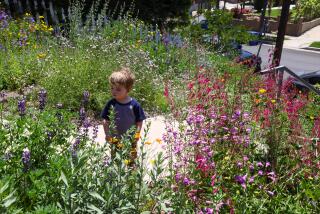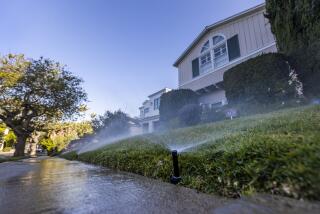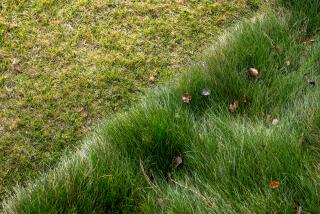CONSUMERS : Drought Solutions May Be in Your Own Back Yard
- Share via
March’s showers may have dampened your enthusiasm to conserve water, but the need to cut usage remains critical.
Although rains have given homeowners a welcome, if brief, respite from outside watering, experts say Californians could have an even more positive effect on the state’s worst-ever drought by taking closer looks at their yards. They recommend better watering practices and yard maintenance, more efficient delivery systems and more drought-resistant plants, trees and lawns.
“Over-watering is probably one of our biggest problems and always has been,” says Tom Ash, landscape-water conservation expert at University of California Cooperative Extension at Riverside. “People save water, not plants. And people can cut their water use 10% to 15% without blinking an eye or hurting their plants.”
Inspect your lawn to see whether it needs watering, he says, instead of automatically turning on the sprinklers.
Tom Jamentz, manager of water conservation for the Los Angeles Department of Water and Power, says: “A lot of people get into a routine where they water three times a week. They don’t need to do that. If you step on the grass and it springs back, it doesn’t need water. I have watered my lawn for three minutes since January. It started to brown a little around the edges, but it’s holding up quite well.”
Lawn aeration also can help keep grass in good shape and therefore more drought-resistant, says Ash, who also runs Landscapes Southern California Style. The Riverside water-conservation demonstration garden is sponsored by the Western Municipal Water District and University of California Cooperative Extension in Riverside.
“Aerating is a good horticulture technique,” Ash says. “You get better water penetration and water percolation into the soil, and have better plant health. There’s nothing tricky about it. You can rent hand aerators for a small piece of lawn or rent a machine for a couple of hours on a Saturday for a larger lawn. You put 1 1/2- to 2 1/2-inch holes down into the soil, then spread on a thin layer of mulch, fertilize and water it.”
Ash adds that healthy plants withstand a drought better: “We’ve lost a lot of pine trees all over the state. The four-year drought has weakened them, then they get insects and pests. It’s like weakening our immune system. And the record frost this year didn’t help.”
In addition, experts advise limiting lawn size because lawns take more water than trees and shrubs. Ash recommends that front lawns be replaced by ground cover, trees and shrubs.
“I tell them to keep it where you use it,” he says. “How many people barbecue in their front yard? They use the back.”
Drip irrigation will also conserve water while keeping plants, shrubs and trees healthy. It delivers water slowly to plant bases and keeps roots moist. Various drip watering kits are available, ranging in price from about $30 to $100.
Ash suggests retrofitting all spray irrigation: “People should adapt their irrigation system . . . and their sprinklers to drip. They should use drip irrigation with all trees and shrubs.”
Consumers can buy a soaker hose ($15 for 25 feet), made of porous recycled rubber that allows water to “weep” into the soil around plants, shrubs and trees.
Mulching also cuts water need and keeps weeds down, Ash says. He advises using a 3- to 5-inch layer of mulch around all trees and shrubs.
He also recommends that homeowners try water cycling to reduce potential run-off: Instead of watering for 10 minutes at a time, water for three minutes each at 5, 6 and 7 p.m.
If you’re unsure just how much water plants and shrubs should have, moisture meters (about $5) are available at many garden stores or building supply centers. Insert the meter probe to root level and an indicator will show whether the plant is dry, moist or wet.
Horticulturists and conservation experts also recommend that consumers stick to “water-thrifty” plants when installing new lawns, gardens and trees.
Says Ash: “There are plenty of trees and shrubs that have the best record for water conservation . . . that will fit in and be more water efficient. People should choose ones from a parallel type of climate. Around the world there are five areas, including California, with a Mediterranean climate.”
He recommends Australian plants like eucalyptus, acacia and cassia, and South African plants such as Agapanthus (Lily of the Nile) and Day Lily.
“Or try the California poppy,” he adds. “All those use far less water than pansies, petunias, impatiens, camellias or azaleas. Or from the Mediterranean are Italian stone pines, olive trees. And you can use rosemary as a ground cover.”
He also suggests grouping (hydro-zoning) plants together according to their water needs.
“We need people to change their attitude and perception of what landscaping ought to be for where we live,” says Ash. “They actually can have more plants for less water and less maintenance.”
Still, if you want colorful pansies, petunias and impatiens, he recommends planting them in pots “so you’ll have more control of the water situation. You can water them with shower water or dishwater.”
Horticulturists also stress that certain types of grasses are better adapted than others to the California climate. Most recommend “warm-season grasses” that require less water. The drawback, however, is that those grasses become dormant in the winter, losing their color.
“We’ve been working on water requirements of various grasses used in California,” says Victor Gibeault, an environmental horticulturist at UC Cooperative Extension. “The warm-season grasses require less irrigation water and their water-use rate is lower than the cool-season grasses. Once the warm-season grasses are established, you can water as infrequently as possible.” Bermuda grasses, seashore paspalum and zoysia are warm-season grasses and require about 20% to 25% less water cool-season types.
Cool-season grasses--Kentucky bluegrass, perennial rye grass or tall fescue--remain green year-around, “but they’re not as adapted to this area,” Gibeault says. “The most drought-resistant of the three is the tall fescue.”
Gibeault and other UC horticulturists are evaluating and breeding new grasses that will use less water yet retain their color all year. But testing results, he says, are “several years away from release.”






